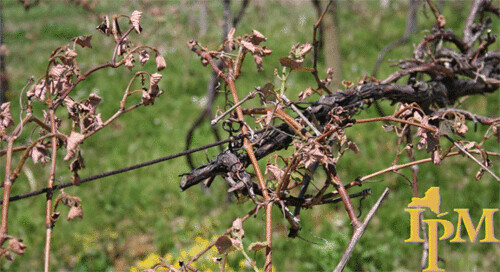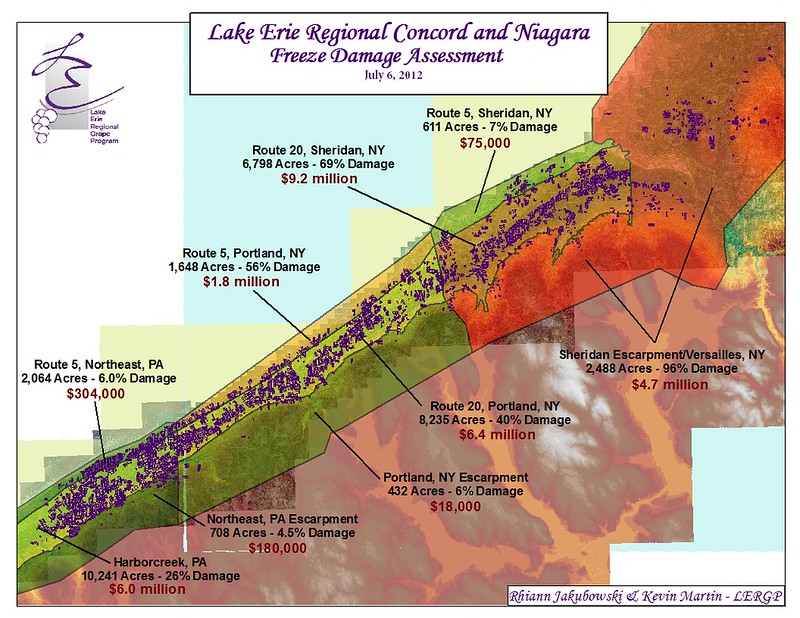2012 Frost Damage
Kevin Martin, Extension Educator, Business Management
Lake Erie Regional Grape Program
Last Modified: March 20, 2013
This region has nearly 29,000 acres of Concord production. With 2011 weather conditions contributing to above average fruiting potential, production should have been 175,000 tons. Such production would yield nearly 10 million gallons of 68 brix concentrate, conservatively valued at 150 million dollars. A more aggressive valuation of the total crop would reach 200 million dollars.
An unseasonably warm March had many vineyards in the Lake Erie grape belt at the bud swell stage or further when the first of up to 11 freeze events occurred on March 27. Of the 11 freeze events, two events have been identified as causing the majority of primary and secondary bud damage. The first freeze event on March 27, where lows ranged from 18 to 26 F caused significant primary bud damage along the lake plain and vineyards on the escarpment located well beyond the moderating effects of Lake Erie. Initial damage ratings of primary bud loss ranged from 0% along the lakeshore to 14.2 on the escarpment. The second critical freeze event occurred over the weekend of April 28 and 29 resulting in a collective primary bud loss of 4.53% to up to 100%.

Figure 1. Photo of 100% primary bud mortality in the Lake Erie Region.
Many vineyards with delayed development that escaped major damage during the March 27 freeze event incurred major damage over the April 28 and 29 event. Ratings at this point in time have not taken into account secondary bud damage. (See map)Bud Loss and Impact on Crop. In the scenario of 40% primary bud loss, we would expect a 30% reduction in crop size assuming an average performance of secondaries. Local climate variation and multiple frost events have made an accurate assessment slightly more challenging. Despite some very cold temperatures damage varies from less than 5% primary loss to 100% damage. Secondary bud damage is also severe in localized areas.
Assuming, overall, a 30% reduction in crop size the total direct economic loss for the industry would range between $45 and $60 million. Gross farmer loss would be approximately $13 million. That total loss is reduced by the potential for crop insurance claims. It will take some more research to try and get a handle on the potential value of crop insurance claims. It will depend significantly on block identification and volatility. With total average estimated crop loss at 50%, the average grower with CAT coverage would not have a claim. However, we know the losses are acute in certain blocks and growers have the ability to separate blocks and insure for higher levels of coverage with buy up plans.
Regional Economic Impact. This region should be aware of the impact this direct loss may have. There is a multiplier effect on these losses that will change spending patterns for farmers, processor employees and farm workers. Changes in spending patterns can impact small business revenue and sales tax. A small county in New York State actually uses the milk price as a factor in budgeting sales tax revenue. Keep in mind that business expenses do not result in sales tax. Any impact on sales tax that a county sees from lower milk prices or grape crop would be due to a multiplier. A multiplier effect in this scenario is a community effect, see figure one for illustrative purposes1.
Another factor in this economic loss is the global nature of the business. This loss is not shouldered entirely by the region. Using bulk juice as a valuation, rather than retail price does focus on what value this region adds. Even so, shareholders, distributors and others will feel some of this economic loss.

Upcoming Events
LERGP Coffee Pot Meeting #2
May 8, 2024 : LERGP Coffee Pot Meeting
Irving, NY
Come join us for timely and pertinent vineyard discussion, coffee, donuts, camaraderie and pesticide credits.
LERGP Coffee Pot Meeting #3
May 15, 2024 : LERGP Coffee Pot Meeting
Ripley, NY
Come join us for timely and pertinent vineyard discussion, coffee, donuts, camaraderie and pesticide credits.
LERGP Coffee Pot Meeting #4
May 22, 2024 : LERGP Coffee Pot Meeting
Burt, NY
Come join us for timely and pertinent vineyard discussion, coffee, donuts, camaraderie and pesticide credits.
Announcements
Welcome Andrew Holden to the LERGP team!
In case you have not heard yet, we have filled the vacant position of Business Management Educator. We are pleased to welcome Andrew Holden to our team. Here is a brief introduction with a little background. Please stop in to say hello and introduce yourself. Bring questions- he is ready to get to know you and your farm operation!The Lake Erie Regional Grape Program welcomed Andrew Holden, LERGP's Business Management Specialist, to our team on March 1, 2024, filling the vacancy since May 2023. Andrew pursued his education at Ohio State University, earning a B.S. in Agribusiness and Applied Economics and later obtaining an M.S. in Agricultural and Extension Education. In his previous role he served as the Ashtabula County Agricultural Extension Educator with Ohio State University Extension for the past 5 years. Andrew is eager to bring his passion for agriculture, grapes, and wine along with his economic knowledge to this new position and to the growers in the Lake Erie Grape Region. He is looking forward to engaging with growers to help him understand their needs to ensure that his role equips them with the tools needed for success. His office is located at the Cornell AgriTech campus in Portland, NY (CLEREL).
Commercial Vehicle Awareness slide presentation
NYS Trooper, Matt Luft, presented on Commercial Vehicle Awareness at CLEREL on Thursday, August 2nd. He has given us the permission to share his slides for you to reference at your convenience to share with others or to review. Please reference this link.LERGP Podcasts- check them out!
LERGP POD CASTS Lake Erie Regional Grape Program - Cornell Cooperative Extension
Lake Erie Regional Grape Program - Cornell Cooperative ExtensionYour Trusted Source for Research-Based Knowledge


